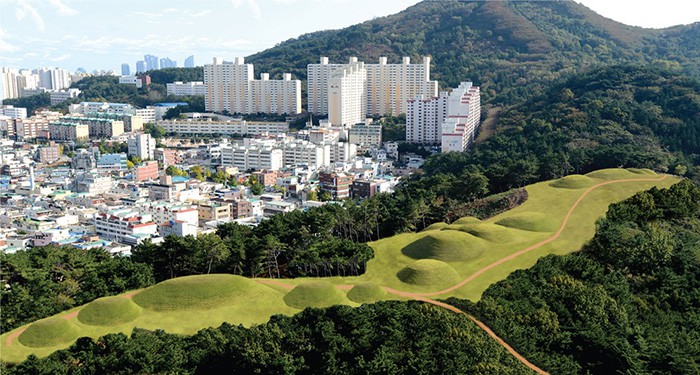
Ancient tombs in Yeonsan-dong, Busan, consist of a line of 18 graves located along the top ridge of Baesan Mountain. There are some 1,000 burial sites in total spread across the adjoining hills.
The ancient burial sites in Yeonsan-dong, Busan, built between the late 400s and 500s on and around Baesan Mountain, are set to become an official historic site, as they retain much valuable information about tomb construction techniques from the Three Kingdoms of Korea period (57 B.C.-A.D. 668).
Archeologists have unearthed some very distinct building techniques at the tombs. Stone walls were coated with clay. Leaves and small branches were put under the clay to prevent rain from permeating inside the tomb. People used a type of soil cement to strengthen the soft ground and to disperse the weight of the burial mound. Also, the mounds were built using various-sized clay balls to make a sturdy foundation. Moreover, traces of lumber that was used to carry the huge stone caps have also been found.
The excavation, which ran from 1987 to 2013, unveiled the biggest stone-lined tomb ever, among tombs from the Three Kingdoms of Korea period, and one of the biggest tombs ever found in Gyeongsang-do. Inside the tomb were armor, helmets and iron hats, believed to have been worn by governors and other officials.
The ancient tombs in Yeonsan-dong, Busan, have both Silla and Gaya characteristics. Also, the relics found in the tombs are a combination of Silla artifacts and some specific to the Busan area. The tombs provide valuable information about the history and burial traditions in ancient Busan and Gyeongsang-do Province in the 400s and 500s.
By Kim Young Shin
Korea.net Staff Writer
Photo: The Cultural Heritage Administration
ysk1111@korea.kr






![[102nd March First Independence Movement Day] American journalist’s Seoul home to be opened to public](https://gangnam.com/file/2021/03/usr_1614255694426-218x150.jpg)
















